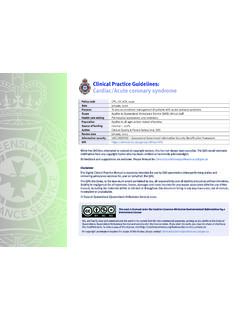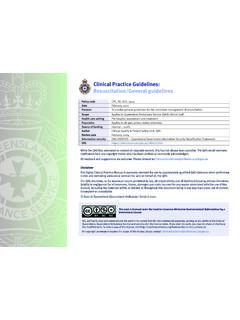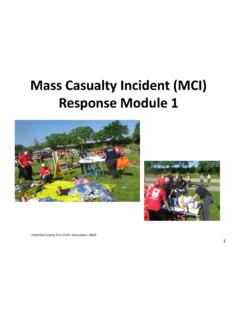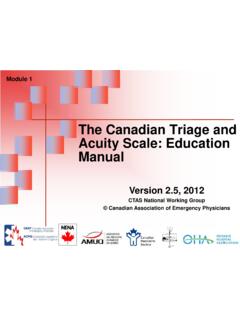Transcription of Clinical Practice Guidelines: Other/Multi casualty incidents
1 While the QAS has attempted to contact all copyright owners, this has not always been possible. The QAS would welcome notification from any copyright holder who has been omitted or incorrectly acknowledged. All feedback and suggestions are welcome. Please forward to: The Digital Clinical Practice Manual is expressly intended for use by appropriately qualified QAS clinicians when performing duties and delivering ambulance services for, and on behalf of, the QAS. The QAS disclaims, to the maximum extent permitted by law, all responsibility and all liability (including without limitation, liability in negligence) for all expenses, losses, damages and costs incurred for any reason associated with the use of this manual, including the materials within or referred to throughout this document being in any way inaccurate, out of context, incomplete or unavailable.
2 State of Queensland (Queensland Ambulance Service) work is licensed under the Creative Commons Attribution-NonCommercial-NoDerivatives International LicenseYou are free to copy and communicate the work in its current form for non-commercial purposes, as long as you attribute the State of Queensland, Queensland Ambulance Service and comply with the licence terms. If you alter the work, you may not share or distribute the modified work. To view a copy of this license, visit copyright permissions beyond the scope of this license please contact: codeCPG_OT_MCI_0221 DateFebruary, 2021 PurposeTo ensure a consistent appproach to the management of multi casualty to Queensland Ambulance Service (QAS) Clinical care settingPre-hospital assessment and to all ages unless stated of fundingInternal 100%AuthorClinical Quality & Patient Safety Unit, QASR eview dateFebruary, 2024 Information securityUNCLASSIFIED Queensland Government Information Security Classification Practice Guidelines.
3 Other/Multi casualty incidents 346 QUEENSLAND AMBULANCE SERVICEM ulti casualty incidentsA multi- casualty incident (MCI) exists when the initial response becomes overwhelmed. This occurs when the number of casualties and/or the severity of their injuries exceed the capacity of the initial crew or crews, preventing effective management and transport. The successful management of a MCI requires the effective use of resources to create balance between the available supply of health personnel and equipment, and the multi- casualty has shown that in the event of a MCI, patient care is optimised if ambulance crews conform to a pre-arranged and rehearsed plan. Scene management should include consideration of various factors including; safety, site assessment, liaison, command, communications, triage , treatment and first unit on scene adopts the command and triage responsibilities ensuring pertinent information is received and given to the communications centre ensuring appropriate resources are available and used as required.
4 The scene commander and triage officer must complete their tasks until relieved by a senior clinician or supervisor. The scene commander provides an initial windscreen sitrepthen collects information necessary for a METHANE scene commander is the contact between the sceneand the communication centre. The triage officer uses the Sieve triage process to facilitatethe prioritisation of treatment and patient movement from theimpact area to the casualty clearing post. Patient numbersand priorities are reported back to the scene the casualty clearing post the triage Trauma Score will validate the casualty s priority for transport. This is referred to as SORT which uses the patient s GCS, respiratory rate and systolic BP to arrive at a score corresponding to a priority level.
5 Transport can commence once enough resources are on scene to manage casualties. Patients are then transported from the scene ensuring the right patient, to the right destination, in the right time. Additional information The QAS emergency response for a MCI comprises strategic,operational and tactical levels, consistent with the QASI ncident Management System [1] framework established bythe QAS State Major Incident and Disaster Plan.[2] Children are often over prioritised taking valuable resourcesaway from more seriously injured adults. Children are notsmall adults and triage systems based on adult physiologydo not triage children accurately. Early identification and notifications of a Chemical,Biological, Radiological, Incendiary and Explosive Incident(CBRIE) is important to ensure safe access, incidentcontainment and appropriate response.
6 If appropriate, the QAS Scene Commander may request theassistance of Medical Evacuation or MedEvac teams bycontacting the appropriate , 2021 Figure During the triage process each patient is given a triage tag with their assessed priority colour and number visible. Patients are then moved from the impact area to the casualty clearing post where patients are assigned to various areas according to the triage WHEN PRINTED UNCONTROLLED WHEN PRINTED UNCONTROLLED WHEN PRINTED UNCONTROLLED WHEN PRINTED347 QUEENSLAND AMBULANCE SERVICEUNCONTROLLED WHEN PRINTED UNCONTROLLED WHEN PRINTED UNCONTROLLED WHEN PRINTED UNCONTROLLED WHEN PRINTED348 QUEENSLAND AMBULANCE SERVICECPG: Clinician safetyCPG: Standard caresTransport to hospital following direction from Scene Commander or Transport OfficerPre-notify as appropriateNote: Clinicians must only perform procedures for which they have received specific training and authorisation by the.
7 Report all pertinent information to Scene Commander Sieve initial triage Patient movement to casualty clearing post SORT secondary triage Appropriate treatment to stabilise for transportConsider: Site Assessment Scene Assessment METHANE reportWHERE APPROPRIATE DELEGATE ROLES: Liaison Officer Marshalling Officer Transport OfficerWindscreen Sitrep CBRIE Incident? YCPG: CBRIEM anage as per:NTriage Officer and all further personnel Scene Commander METHANE: M ajor incident confirmation E xact location T ype of incident H azards identified A ccess via N umber of patients (adult/paediatric) nature and priority of injured E mergency services/resources requiredUNCONTROLLED WHEN PRINTED UNCONTROLLED WHEN PRINTED UNCONTROLLED WHEN PRINTED UNCONTROLLED WHEN PRINTED















